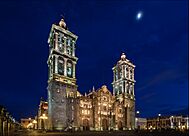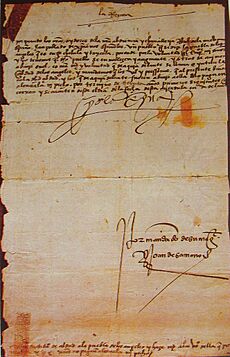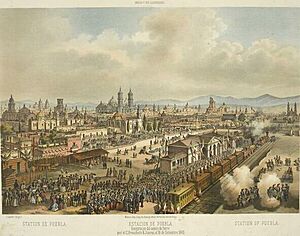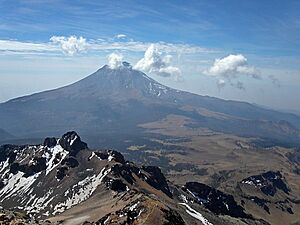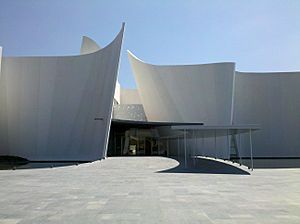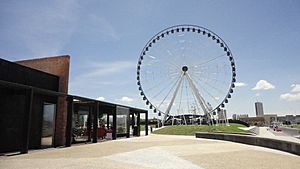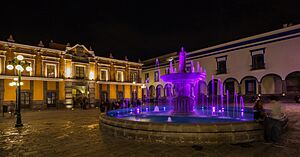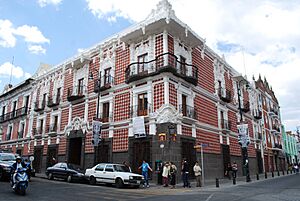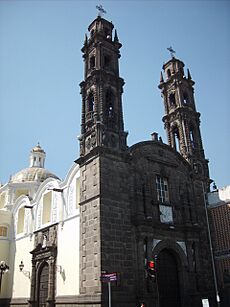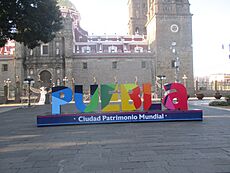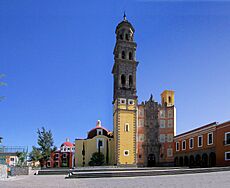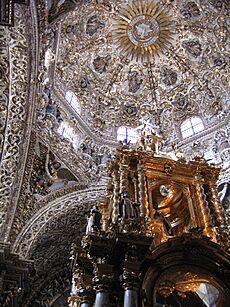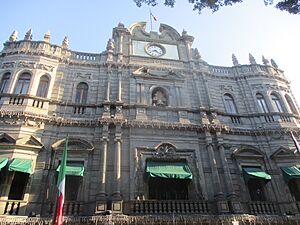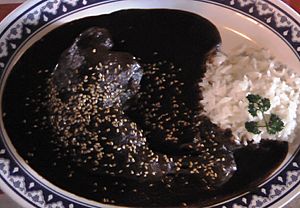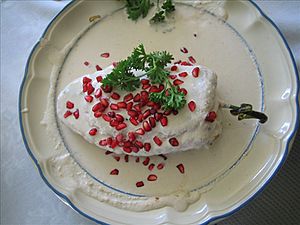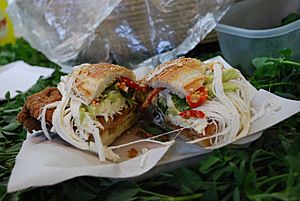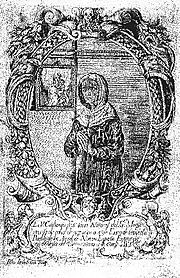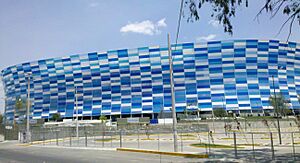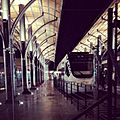Puebla (city) facts for kids
{{Infobox settlement | name = Puebla | official_name = Heroica Puebla de Zaragoza | native_name = Puebla de Zaragoza | other_name = Puebla de los Ángeles, Cuetlaxcoapan | settlement_type = Metropolis
| image_skyline =
| image_flag = Bandera de Heroica Puebla de Zaragoza, Mexico.svg | image_seal = | image_shield = Escudo de Puebla de los Ángeles (Puebla de Zaragoza).svg | nickname = The Reliquary of Americas, the City of Angels, The Angelopolis | motto = | image_map = Puebla Mun-PUE.svg | mapsize = 180px | map_caption = Location of Puebla within the state | image_map1 = Mexico map, MX-PUE.svg | mapsize1 = | map_caption1 = Location of the state within Mexico | pushpin_map = Mexico#North America | pushpin_label_position = above | pushpin_mapsize = 300 | pushpin_map_caption = Location in Mexico
| coordinates = 19°02′N 98°11′W / 19.033°N 98.183°W | subdivision_type = Country | subdivision_name = Mexico | subdivision_type1 = State | subdivision_name1 = Puebla | subdivision_type2 = Municipality | subdivision_name2 = Puebla | established_title = Founded | established_date = 16 April 1531 | established_title2 = Municipal status | established_date2 = 1821
| government_type = | government_footnotes = | leader_title = Municipal President | leader_name = Eduardo Rivera
| total_type = Municipality | unit_pref = | area_footnotes = | area_total_km2 = 534.32 | area_land_km2 = | area_water_km2 = | area_water_percent = | area_urban_km2 = 689,87 | area_urban_sq_mi = 269.48 | elevation_m = 2135 | elevation_point = of seat
| population_footnotes = | population_total = 1,692,181 | population_as_of = 2020 | population_density_km2 = | population_metro = 3,344,000 | population_note = | population_demonym = Poblano, Angelopolitano | population_rank = 14th in North America
5th in Mexico | demographics_type1 = GDP (PPP, constant 2015 values) | demographics1_footnotes = | demographics1_title1 = Year | demographics1_info1 = 2023 | demographics1_title2 = Total | demographics1_info2 = $53.8 billion | demographics1_title3 = Per capita | demographics1_info3 = $16,100
| timezone = CST | utc_offset = −6 | timezone_DST = CDT | utc_offset_DST = −5
| postal_code_type = Postal code (of seat) | postal_code = 72000 | area_code = 222, 221 | iso_code = MX-PUE | blank_name = | blank1_name = Demonym | blank1_info = | blank_name_sec1 = HDI | website = Official site: http://www.pueblacapital.gob.mx/ | footnotes = {{designation list | embed=yes | designation1 = WHS | designation1_offname = Historic Centre of Puebla | designation1_date = 1987 {{small|(11th [[World Heritage Committee|session])}} | designation1_type = Cultural | designation1_criteria = ii, iv | designation1_number = 416 | designation1_free1name = Region | designation1_free1value = Latin America and the Caribbean }} }} Puebla de Zaragoza, often called Puebla, is a large and important city in Mexico. Its full official name is Heroica Puebla de Zaragoza. It was once known as Puebla de los Ángeles.
Puebla is the capital and biggest city in the state of Puebla. It is the fourth largest city in Mexico. It is located in the southern part of Central Mexico. The city is about 100 km (62 miles) east of Mexico City. It is also about 220 km (137 miles) west of Veracruz, a major port city.
The city was founded in 1531 in an area called Cuetlaxcoapan. This name means "where serpents change their skin." It was built between two important native settlements, Tlaxcala and Cholula. This valley was not heavily populated before the Spanish arrived. It was mainly used for "flower wars" between different groups.
Puebla is famous for its history and beautiful buildings. These buildings show styles from the Renaissance to Mexican Baroque. Because of its unique architecture, the city became a World Heritage Site in 1987. Puebla is also known for its delicious food, like mole poblano and chiles en nogada. It is also famous for its special pottery called Talavera. Most of Puebla's economy today comes from its many industries.
Puebla is one of Mexico's largest cities and metropolitan areas. It has about 3.3 million people. It is a key center for eastern-central Mexico. Many students from nearby states come to study at its well-known universities. These include BUAP, UDLAP, and Ibero. The city is also a big industrial hub. It has the world's largest Volkswagen factory outside Germany. There is also an Audi plant nearby. Many companies that supply parts to these car factories have also opened in Puebla.
Contents
History of Puebla
Early Times and Foundation
Some historians believe that the area where Puebla is now was not lived in much before the 15th century. At that time, it was mainly used for "Flower wars" between different groups.
The idea for Puebla started in 1530. A bishop named Julián Garcés wrote to the Spanish queen. He said a Spanish town was needed between Mexico City and Veracruz. A legend says the bishop had a dream. He saw angels marking out the city's location in a beautiful valley. This dream led to Puebla's first name, Puebla de los Ángeles (City of Angels). This is also why it's nicknamed Angelópolis today.
City's Coat of Arms
The city's coat of arms shows a castle with five towers. This castle is protected by angels. The letters K. V. stand for Charles V, Holy Roman Emperor. He was also known as Charles I of Spain. Below the castle, there are seven rivers that flow through the city.
Puebla in Colonial Times
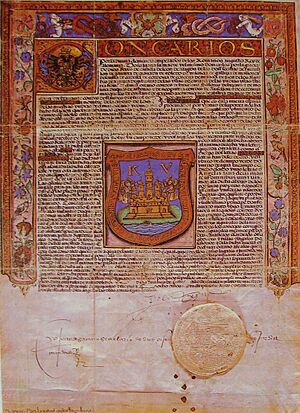
Puebla was founded on April 16, 1531. It was built as a Spanish city, not on top of an existing native city. The first attempt to build it failed because of floods. The city was moved to higher ground. It became an important stop between Mexico City and Veracruz, the main port to Spain.
Puebla grew quickly and became very important in New Spain. It provided food and textiles to the capital. It also had strong trade links with other parts of Mexico. The city received its coat-of-arms in 1538. It was given titles like "Noble and Loyal City" by the Spanish Crown.
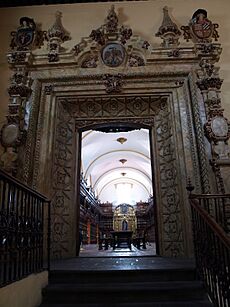
The city's layout was classic Spanish design. It centered around a main square, now called the Zócalo. Weekly markets were held here, where native sellers brought their goods. By the late 1500s, the city covered 120 blocks. The new Cathedral started being built in 1575.
Puebla's good climate and location helped it become the second most important city in New Spain. The city council, made up of Spaniards, had some power over the city's politics. Puebla's land grew to reach from what is now Veracruz to Guerrero states. Streets were paved with stone between 1786 and 1811. During the Mexican War of Independence, Puebla helped by printing independence plans. After Mexico became independent in 1827, all Spaniards were asked to leave the city.

Modern History
In 1847, U.S. forces took the city during the Mexican-American War. They left in 1848 after a peace treaty.
On May 5, 1862, during the French intervention, Mexican forces won the famous Battle of Puebla. They defeated the French army. Because of this victory, the city's name was changed to Puebla de Zaragoza in 1862. The "5 de Mayo" (Cinco de Mayo) holiday is a huge yearly event here. The French attacked again in 1863 and took the city. They left in 1866, and rebuilding began.
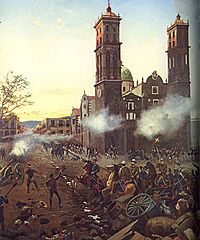
By the late 1800s and early 1900s, Puebla was still important for culture and business. It had a strong textile industry. Many people from Europe and Lebanon moved to the city.
Before the Mexican Revolution, the Serdán siblings (Carmen, Máximo, and Aquiles Serdán) planned against the government. Their plans were found out, and they fought federal troops. The Serdán brothers were killed on November 18, 1910. During the Revolution, different groups controlled the city at different times.
From 1931 onwards, Puebla grew a lot. It absorbed nearby towns into the city. In 1950, it officially became "Heroica Puebla de Zaragoza." In 1977, the government declared it a Zone of Historical Monuments. In 1987, UNESCO named the historic centre of Puebla a World Heritage Site.
Puebla Municipality
The city of Puebla is the main part of the Puebla Municipality. This municipality is in the west-central part of Puebla State. It shares borders with several other municipalities and the State of Tlaxcala.
The city of Puebla is the government center for 482 other communities. The total area of the municipality is 534.32 km2. Most of the municipality's population, about 94%, lives in the city itself.
Environment and Nature
Much of the municipality's original forests have been cut down. This includes areas on the lower parts of the Malinche volcano.
Higher up on the Malinche volcano, you can still find beautiful forests. These forests have pine trees, holm oaks, and other tree types. Common trees include Montezuma Pine and Hartweg's Pine.
You can find small animals like rabbits and skunks here. Birds like owls, buzzards, and wild waterfowl also live in the area.
Geography of Puebla
Puebla is in the Valley of Puebla, also known as the Valley of Cuetlaxcoapan. This valley is surrounded by mountains and volcanoes. It is about 40 km (25 miles) east of the Popocatépetl and Iztaccíhuatl volcanoes. This means residents often have amazing views of their snowy peaks. Because Popocatépetl is close, Puebla sometimes gets ash and dust from the volcano when it is active. The most recent activity was on May 19, 2023.
The La Malinche volcano, which is not active, is north of the city. The Pico de Orizaba volcano is to the east. Several rivers flow through the area, including the Atoyac, Alseseca, and San Francisco rivers. The Atoyac River connects to the Lake of Valsequillo, where a dam has been built.
Climate in Puebla
Puebla has a subtropical highland climate. This means it's in a tropical area but is high up, about 2100 meters (6,890 feet) above sea level. In Mexico, it's called a "subhumid temperate climate with summer rains."
It rarely gets very hot in Puebla. Temperatures usually go above 29°C (84°F) only about three days a year. Nights are cool all year round. Puebla has dry, mild winters from mid-October to February. Spring is warm from March to mid-May. Then comes a rainy season from mid-May to mid-October.
| Climate data for Puebla, Mexico (1951–2010) | |||||||||||||
|---|---|---|---|---|---|---|---|---|---|---|---|---|---|
| Month | Jan | Feb | Mar | Apr | May | Jun | Jul | Aug | Sep | Oct | Nov | Dec | Year |
| Record high °C (°F) | 29.5 (85.1) |
32.0 (89.6) |
35.0 (95.0) |
36.0 (96.8) |
36.5 (97.7) |
34.0 (93.2) |
33.0 (91.4) |
33.0 (91.4) |
32.0 (89.6) |
33.0 (91.4) |
31.0 (87.8) |
30.5 (86.9) |
36.5 (97.7) |
| Mean daily maximum °C (°F) | 23.0 (73.4) |
23.9 (75.0) |
25.9 (78.6) |
27.5 (81.5) |
28.0 (82.4) |
26.4 (79.5) |
25.3 (77.5) |
25.3 (77.5) |
24.8 (76.6) |
24.8 (76.6) |
24.4 (75.9) |
23.6 (74.5) |
25.2 (77.4) |
| Daily mean °C (°F) | 13.9 (57.0) |
15.0 (59.0) |
17.1 (62.8) |
19.0 (66.2) |
19.8 (67.6) |
19.4 (66.9) |
18.4 (65.1) |
18.4 (65.1) |
18.2 (64.8) |
17.3 (63.1) |
15.8 (60.4) |
14.5 (58.1) |
17.2 (63.0) |
| Mean daily minimum °C (°F) | 4.9 (40.8) |
6.2 (43.2) |
8.4 (47.1) |
10.5 (50.9) |
11.7 (53.1) |
12.5 (54.5) |
11.6 (52.9) |
11.5 (52.7) |
11.5 (52.7) |
9.8 (49.6) |
7.2 (45.0) |
5.4 (41.7) |
9.3 (48.7) |
| Record low °C (°F) | −5.5 (22.1) |
−1.5 (29.3) |
−2.0 (28.4) |
1.0 (33.8) |
5.0 (41.0) |
5.0 (41.0) |
4.0 (39.2) |
4.5 (40.1) |
0.0 (32.0) |
2.0 (35.6) |
−4.5 (23.9) |
−6.0 (21.2) |
−6.0 (21.2) |
| Average precipitation mm (inches) | 12.0 (0.47) |
8.5 (0.33) |
9.4 (0.37) |
28.8 (1.13) |
83.5 (3.29) |
193.5 (7.62) |
161.6 (6.36) |
172.4 (6.79) |
197.1 (7.76) |
79.1 (3.11) |
18.0 (0.71) |
5.2 (0.20) |
969.1 (38.15) |
| Average precipitation days (≥ 0.1 mm) | 1.6 | 1.7 | 2.4 | 6.2 | 12.7 | 18.2 | 17.9 | 18.2 | 18.7 | 10.0 | 3.1 | 1.2 | 111.9 |
| Average relative humidity (%) | 53 | 53 | 47 | 52 | 55 | 63 | 67 | 68 | 65 | 62 | 52 | 60 | 58 |
| Mean monthly sunshine hours | 263 | 280 | 285 | 266 | 245 | 200 | 212 | 202 | 183 | 228 | 259 | 253 | 2,876 |
| Source 1: Servicio Meteorológico National (humidity 1981–2000) | |||||||||||||
| Source 2: Ogimet (sun 1981–2010) | |||||||||||||
Things to See and Do in Puebla
The beautiful architecture of Puebla is why it's a UNESCO World Heritage Site. You can see styles like Baroque, Renaissance, and Classic in over 5,000 buildings. Puebla is known as the "cradle of Mexican Baroque." It is one of Mexico's most important colonial cities.
Parks, Squares, and Districts
Even with many new shopping malls, the Zócalo (main square) is still the heart of the city. Important buildings like City Hall and the cathedral surround it. Most streets in Puebla are numbered, starting from the Zócalo. El Parián is a market for arts and crafts.
Cuexcomate is a 13-meter-tall (43-foot) geyser cone. It's not active anymore. You can go down a spiral staircase into its crater. People used to mistakenly call it the smallest volcano. The name "Cuexcomate" comes from a native word meaning "clay pot." It was even used to store food!
Museums and Art Galleries
The Amparo Museum is in two old colonial buildings. It has fourteen rooms with ancient pottery, sculptures, and art from different Mexican cultures. You can see pieces from the Zapotec, Huasteca, Maya, Olmec, and Aztec cultures. It also has colonial furniture and modern art.
The Biblioteca Palafoxiana (Palafoxiana Library) was started in 1646. It was the first public library in the Americas. Today, it holds over 42,000 books and 5,000 old papers. These items date from 1473 to 1910. UNESCO has named it a world heritage site.
The Centro Cultural Santa Rosa is in a 17th-century building. It used to be a convent. This is where the famous mole poblano dish is said to have been invented. Today, it hosts exhibitions, shows, and art classes.
The Museo de la Revolución (Museum of the Revolution) was the home of Aquiles Serdán. He was a key figure in the Mexican Revolution. The museum shows his work and personal items. It also has temporary exhibits and workshops.
Fort Loreto and Fort Guadalupe are important historical sites. They played a big role in the Battle of Puebla in 1862. Fort Loreto has a museum called the Museo de la No Intervención. It also has the Fort War Museum, with cannons, swords, and documents from the battle.
The Galería de Arte Contemporáneo y Diseño (Gallery of Contemporary Art and Design) shows paintings, sculptures, and other visual arts. It's in an old textile factory from 1908.
The International Museum of the Baroque opened in 2016. It's a museum dedicated to Baroque art. It was designed by a famous Japanese architect, Toyō Itō.
The Casa de Alfeñique is famous for its detailed plaster work. "Alfeñique" is a type of sweet candy. The house was built in 1580. It became the first public museum in Puebla. It has over 1,500 historical items.
The Museo de Arte (Museum of Art) was once a church and hospital. It now shows art from different time periods. The Museum Workshop of Erasto Cortés Juárez was the home of a famous 20th-century artist. It has over 400 of his works and personal items.
Cathedrals and Churches
The Puebla Cathedral took 300 years to build! Construction started in 1575. It was consecrated in 1649, even though it wasn't fully finished. The north tower was added in 1678, and the south tower in 1768.
The cathedral has five sections and fourteen chapels. It features many artworks, including a main dome and altar decorated by Cristóbal de Villalpando. Its bell towers are almost 70 meters (230 feet) tall, making them the tallest in Mexico. The choir seating is made of beautiful wood, onyx, and ivory. In the crypt below, you can see many statues of saints and angels made of onyx.
The Church and Friary of San Francisco has a tall, four-level tower. Its main entrance is decorated with large jars and flowers. Inside, you can find old altarpieces and the mummified body of Sebastian de Aparicio, who is becoming a saint. Franciscan friars still live and work here. They run a school and help with community activities.
The Church of Santo Domingo has a classic stone entrance. The old monastery's front is highly decorated in Baroque style. Inside, the ceiling has two large vaults and gilded altarpieces.
The Chapel of the Rosary is inside the Church of Santo Domingo. Built between 1650 and 1690, it was the first chapel dedicated to the Our Lady of the Rosary. It is full of symbols from New Spain's Baroque art. These symbols were meant to help people learn about Christianity. The chapel's dome looks like the crown of the Virgin Mary. It is decorated with sculpted plaster and gold. There are also paintings showing the life of the Virgin.
Other Important Buildings
The Casa del Deán is the oldest noble house in Puebla. It was built in 1580. It has unique murals, which are the only non-religious ones from the 16th century still in their original place in Mexico.
The Teatro Principal de Puebla (Main Theater of Puebla) opened in 1761. It burned down in 1902 but was rebuilt. It hosts cultural events and art shows from local, national, and international artists.
The Municipal Palace is the city hall. Its front is made of gray stone in a Renaissance style. It has Ionic columns and pediments. The building has a clock and towers on each side.
The Fountain of the China Poblana is a large monument made of stone and Talavera tile. In the center is a sculpture of the China Poblana, over three meters (10 feet) tall. This fountain was opened in 1971.
Puebla's Famous Food
The most famous dish from Puebla is mole poblano. The story of how it was created is a legend. One story says 16th-century nuns invented it. They mixed many spices, chili peppers, bread, and chocolate to make a sauce for a turkey. The archbishop loved it!
Another story says mole poblano dates back to before the Spanish arrived. The Aztecs had a chili pepper sauce called "chilmulli." However, chocolate was not used in their food. The sauce likely gained ingredients over time during the colonial period. Many food experts today see turkey in mole poblano as a top dish in Mexican cooking.
Another famous dish, chiles en nogada, was also supposedly invented here. The story says three sisters from Puebla created it to impress a general named Agustin de Iturbide. The dish uses green (parsley), white (walnut sauce), and red (pomegranate seeds) to represent the colors of the Mexican flag. It was a big success!
The "cemita" is another signature dish in Puebla. It's a large, well-stuffed sandwich served on a special bun. The cemita bread comes from a French bread introduced in the 1860s. Over time, it changed to fit Mexican tastes. In the early 1900s, people started filling the bread with leftovers like potatoes, beans, or meat. Today, you can find cemitas with all sorts of fillings. It started as a simple meal but is now enjoyed by everyone as a popular fast food.
Talavera Pottery
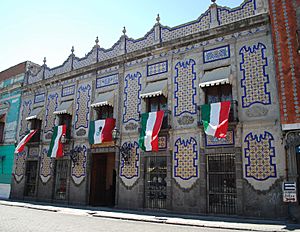
Soon after Puebla was founded, it became known for its beautiful ceramics, especially Talavera. This was because the area had excellent clay. Between 1550 and 1570, Spanish potters came from Spain to teach new techniques. These new methods mixed with native designs to create Poblano Talavera.
The glazing technique was first used for tiles that still decorate many buildings. Later, it was used for pots, plates, and other items. By the mid-1600s, the industry was strong. Guilds were formed to make sure the quality was high. Blue color was only used on the most expensive pieces because it was costly. The period from 1650 to 1750 was called the Golden Age of Talavera.
In 1813, rules for pottery production were removed. This led to a drop in quality, and the Talavera market struggled. Only a few workshops remained. However, in the late 1800s, a man named Enrique Luis Ventosa helped bring Talavera back. Collectors also became interested, and Talavera pieces are now in major museums.
The Story of the China Poblana
The story of the China Poblana is a famous legend. It tells of a young Indian woman named Mirra. She was kidnapped by pirates and taken to India, then to Manila. In Manila, she was sold to a merchant who brought her to Mexico. In Mexico, she was baptized as Catarina de San Juan.
Catarina continued to wear her traditional Indian clothing, a sari. This style might have inspired the "china dress" that became popular in Mexico in the 1600s. After her owner died, she was freed. She lived in a convent and was said to have visions. Catarina de San Juan died in 1688. She was honored as a saint in Puebla for a while. Today, a church in Puebla is known as "La Tumba de la China Poblana" because her remains are there.
Puebla's Secret Tunnels
For a long time, people talked about secret tunnels under Puebla. Many thought it was just an urban legend. But in 2015, these tunnels were found! They are believed to be up to 500 years old. They might stretch for more than 10 km (6 miles) under the city.
Cinco de Mayo Celebration
Every year on May 5, Puebla celebrates the Battle of Puebla. This battle was fought in 1862 when Mexican forces defeated French troops. The celebrations last for several days. They include concerts, talks, and other cultural events.
On May 5th itself, there is a very large parade. There is also a re-enactment of the battle. The parade includes the Mexican Army, Navy, and Special Forces. Soldiers dress in old uniforms. They also show modern military vehicles. School bands, students, and floats from Mexico and other countries join the parade.
Education in Puebla
Puebla has many universities, second only to Mexico City in Mexico. The main university is the Benemérita Universidad Autónoma de Puebla (BUAP). It is the oldest and largest university in the region, founded in 1587. Another public university is the Instituto Tecnológico de Puebla (ITP).
Puebla is also home to some very respected private universities. These include Tecnologico de Monterrey, Universidad Iberoamericana Puebla, and the Universidad de las Americas Puebla (UDLAP).
Sports in Puebla
| Team | Sport | League | Stadium |
|---|---|---|---|
| Club Puebla | Association football | Liga MX | Estadio Cuauhtémoc |
| Pericos de Puebla | Baseball | Mexican Baseball League | Estadio Hermanos Serdán |
| Aztecas UDLAP | College football | ONEFA | Estadio Templo del Dolor |
| Borregos Salvajes Puebla ITESM | College football | ONEFA | Cráter Azul |
Puebla has a professional football (soccer) team called Puebla F.C.. The biggest football stadium in the city is Cuauhtémoc Stadium. It can hold 51,720 people. It was built in 1968 for the 1968 Olympic Games. Matches for the 1970 and 1986 FIFA World Cups were also played there. In 2015, the stadium was updated to meet new FIFA standards. It is now the fourth largest stadium in Mexico.
Puebla also has a professional baseball team, the Pericos de Puebla.
For college American football, Puebla has the "Aztecas" team from the Universidad de las Américas. They have won the Mexican College Football Organization (ONEFA) championship three times. Their home stadium is called the Templo del Dolor (Temple of Pain).
Puebla's Economy
Some farming still happens in the municipality. However, as the city grows, farming is becoming a smaller part of the economy. Farmers grow crops like corn, beans, wheat, and fruits. They also raise animals like cattle, pigs, and horses. Most farming happens on small plots of land around the city's edges.
Industry makes up about 80% of Puebla's economy. Most factories are on the city's outskirts and in nearby towns. Key products include metals, chemicals, electrical items, and textiles. Big employers are Hylsa and the Volkswagen car plant. Food processing is also a growing industry. Many industries are grouped in special parks, like the 5 de Mayo Industrial Park. Popular shopping centers include the Angelópolis Lifestyle Center and Parque Puebla.
Transportation in Puebla
Puebla is served by Puebla International Airport. This airport is part of the group of airports for Mexico City. It offers flights within Mexico and to the United States. The airport is also used for manufacturing, importing, and exporting goods.
In 2013, the first line of the RUTA rapid transit bus system opened. In 2014, a second line was added, and in 2019, a third line. These bus lines help people travel across the city. The Puebla-Cholula Tourist Train opened in 2017. It connected Puebla with Cholula. However, this train stopped running on December 31, 2021.
Famous People from Puebla
- Sergio Almaguer – football coach
- Albert Baez – physicist, father of singer Joan Baez
- Martha Mariana Castro – actress
- Luisito Comunica - YouTuber
- Alejandro Edda - actor
- Alberto Garcia Aspe – football executive
- Adrián Goransch - footballer
- Manuel Lapuente – football coach
- Ángeles Mastretta – writer
- Gabriel Palmeros - footballer
- Carlos Poblete – football coach
- José Luis Sánchez Solá – football coach
- Regina Torné – actress
Sister Cities
Puebla has "sister city" relationships with many cities around the world:
|
|
See also
 In Spanish: Puebla de Zaragoza para niños
In Spanish: Puebla de Zaragoza para niños



